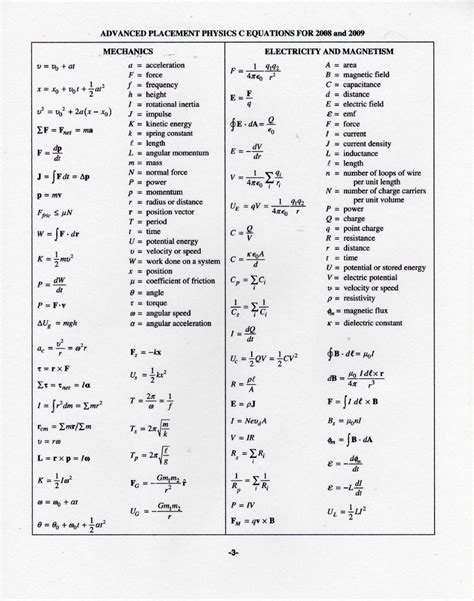Master Mechanics with These Equations
- Linear Motion:
- Velocity: v = dx/dt
- Acceleration: a = dv/dt
- Displacement: x = x_0 + vt + 1/2 at^2
-
Velocity squared: v^2 = v_0^2 + 2a(x – x_0)

-
Projectile Motion:
- Horizontal displacement: x = v_0t cos θ
- Vertical displacement: y = v_0t sin θ – 1/2 gt^2
-
Velocity: v = v_0cos θ î + (v_0sin θ – gt) ĵ
-
Circular Motion:
- Centripetal acceleration: a_c = v^2/r
- Period: T = 2πr/v
-
Frequency: f = 1/T
-
Momentum and Impulse:
- Momentum: p = mv
-
Impulse: J = Δp = FΔt
-
Energy:
- Kinetic energy: K = 1/2 mv^2
- Gravitational potential energy: U_g = mgh
- Elastic potential energy: U_e = 1/2 kx^2
- Power: P = W/t
- Work: W = Fd cos θ
Conquer Electromagnetism with These Formulas
- Electric Fields:
- Electric field: E = kq/r^2
- Electric potential: V = kq/r
-
Capacitance: C = Q/V
-
Magnetic Fields:
- Magnetic field due to a current-carrying wire: B = μ_0 I/2πr
- Magnetic force on a moving charge: F = qvB sin θ
-
Inductance: L = Φ/I
-
Electromagnetic Waves:
- Speed of light: c = 3 x 10^8 m/s
- Wavelength: λ = c/f
- Frequency: f = c/λ
Master Waves with These Equations
- Wave Properties:
- Velocity: v = fλ
- Frequency: f = 1/T
- Wavelength: λ = v/f
-
Amplitude: A
-
Standing Waves:
- Wavelength of a standing wave on a string: λ = 2L/n
-
Frequency of a standing wave on a string: f = n(v/2L)
-
Doppler Effect:
- Doppler effect for sound: f’ = f(v ± v_o) c
- Doppler effect for light: λ’ = λ(1 ± v/c)
Thermodynamics: Heat and Temperature
- Heat Capacity:
- Heat capacity of a substance: C = Q/ΔT
-
Specific heat capacity: c = C/m
-
Phase Transitions:
- Heat of fusion: L_f = Q/m
-
Heat of vaporization: L_v = Q/m
-
Ideal Gas Law:
- PV = nRT
Modern Physics Concepts
- Special Relativity:
- Time dilation: Δt’ = Δt / γ
- Length contraction: Δx’ = Δx / γ
-
γ = (1 – v^2/c^2)^-1/2
-
Quantum Physics:
- De Broglie wavelength: λ = h/p
- Heisenberg uncertainty principle: Δx Δp ≥ h/4π
Effective Strategies to Master Physics C
- Practice regularly: Complete practice problems and review concepts daily.
- Understand concepts: Focus on understanding the underlying principles rather than memorizing formulas.
- Visualize problems: Draw diagrams and use simulations to visualize the scenarios.
- Collaborate with peers: Form study groups or ask for help from friends or a tutor.
- Utilize resources: Take advantage of textbooks, online notes, and review sessions.
Why Physics C Matters
- Enhances critical thinking: Physics C challenges students to analyze problems, develop logical arguments, and solve complex equations.
- Prepares for STEM careers: A strong foundation in Physics C is essential for students pursuing careers in science, technology, engineering, or mathematics.
- Promotes innovation: Physics C fosters creativity and encourages students to think outside the box, leading to potential breakthroughs and technological advancements.
Benefits of the Physics C Formula Sheet
- Quick reference: Provides a convenient way to access important formulas during exams or review sessions.
- Time-saving: Eliminates the need to search for formulas during tests, saving valuable time.
- Memory reinforcement: Regularly consulting the formula sheet reinforces key concepts and formulas in memory.
- Confidence booster: Having a formula sheet on hand can provide a sense of confidence and reduce test anxiety.
Frequently Asked Questions (FAQs)
1. What is the difference between Physics C: Mechanics and Physics C: Electricity and Magnetism?
Physics C: Mechanics focuses on the concepts of motion, forces, and energy, while Physics C: Electricity and Magnetism covers topics related to electric fields, magnetic fields, and electromagnetic waves.
2. How can I prepare for the Physics C AP exam?
Regularly practice problems, understand the concepts, utilize resources, and collaborate with others. Consider taking review courses or attending workshops offered by your school or local educational institutions.
3. What types of problems are on the Physics C AP exam?
The exam includes multiple-choice questions, free-response questions, and an experimental design question. Problems cover a range of topics within mechanics, electricity and magnetism, and waves.
4. Is a formula sheet provided on the Physics C AP exam?
Yes, a formula sheet is provided for both the Physics C: Mechanics and Physics C: Electricity and Magnetism exams.
5. How many times can I take the Physics C AP exam?
You can take the Physics C AP exam up to three times.
6. What score should I aim for on the Physics C AP exam?
A score of 3 or higher is considered passing, while a score of 5 is considered equivalent to a college-level introductory Physics C course.
7. What are some potential career paths with a strong background in Physics C?
Physics C prepares students for careers in engineering, physics, astronomy, astrophysics, and other STEM fields.
8. How can I apply Physics C concepts to real-world problems?
Physics C principles can be applied to solve problems in areas such as engineering, medicine, sports science, and environmental conservation.
